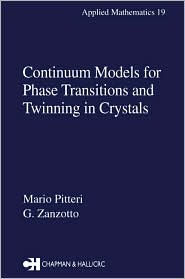Continuum Models for Phase Transitions and Twinning in Crystals
Continuum Models for Phase Transitions and Twinning in Crystals presents the fundamentals of a remarkably successful approach to crystal thermomechanics. Developed over the last two decades, it is based on the mathematical theory of nonlinear thermoelasticity, in which a new viewpoint on material symmetry, motivated by molecular theories, plays a central role.
This is the first organized presentation of a nonlinear elastic approach to twinning and displacive phase transition in crystalline solids. The authors develop geometry, kinematics, and energy invariance in crystals in strong connection and with the purpose of investigating the actual mechanical aspects of the phenomena, particularly in an elastostatics framework based on the minimization of a thermodynamic potential. Interesting for both mechanics and mathematical analysis, the new theory offers the possibility of investigating the formation of microstructures in materials undergoing martensitic phase transitions, such as shape-memory alloys.
Although phenomena such as twinning and phase transitions were once thought to fall outside the range of elastic models, research efforts in these areas have proved quite fruitful. Relevant to a variety of disciplines, including mathematical physics, continuum mechanics, and materials science, Continuum Models for Phase Transitions and Twinning in Crystals is your opportunity to explore these current research methods and topics.
1101428266
This is the first organized presentation of a nonlinear elastic approach to twinning and displacive phase transition in crystalline solids. The authors develop geometry, kinematics, and energy invariance in crystals in strong connection and with the purpose of investigating the actual mechanical aspects of the phenomena, particularly in an elastostatics framework based on the minimization of a thermodynamic potential. Interesting for both mechanics and mathematical analysis, the new theory offers the possibility of investigating the formation of microstructures in materials undergoing martensitic phase transitions, such as shape-memory alloys.
Although phenomena such as twinning and phase transitions were once thought to fall outside the range of elastic models, research efforts in these areas have proved quite fruitful. Relevant to a variety of disciplines, including mathematical physics, continuum mechanics, and materials science, Continuum Models for Phase Transitions and Twinning in Crystals is your opportunity to explore these current research methods and topics.
Continuum Models for Phase Transitions and Twinning in Crystals
Continuum Models for Phase Transitions and Twinning in Crystals presents the fundamentals of a remarkably successful approach to crystal thermomechanics. Developed over the last two decades, it is based on the mathematical theory of nonlinear thermoelasticity, in which a new viewpoint on material symmetry, motivated by molecular theories, plays a central role.
This is the first organized presentation of a nonlinear elastic approach to twinning and displacive phase transition in crystalline solids. The authors develop geometry, kinematics, and energy invariance in crystals in strong connection and with the purpose of investigating the actual mechanical aspects of the phenomena, particularly in an elastostatics framework based on the minimization of a thermodynamic potential. Interesting for both mechanics and mathematical analysis, the new theory offers the possibility of investigating the formation of microstructures in materials undergoing martensitic phase transitions, such as shape-memory alloys.
Although phenomena such as twinning and phase transitions were once thought to fall outside the range of elastic models, research efforts in these areas have proved quite fruitful. Relevant to a variety of disciplines, including mathematical physics, continuum mechanics, and materials science, Continuum Models for Phase Transitions and Twinning in Crystals is your opportunity to explore these current research methods and topics.
This is the first organized presentation of a nonlinear elastic approach to twinning and displacive phase transition in crystalline solids. The authors develop geometry, kinematics, and energy invariance in crystals in strong connection and with the purpose of investigating the actual mechanical aspects of the phenomena, particularly in an elastostatics framework based on the minimization of a thermodynamic potential. Interesting for both mechanics and mathematical analysis, the new theory offers the possibility of investigating the formation of microstructures in materials undergoing martensitic phase transitions, such as shape-memory alloys.
Although phenomena such as twinning and phase transitions were once thought to fall outside the range of elastic models, research efforts in these areas have proved quite fruitful. Relevant to a variety of disciplines, including mathematical physics, continuum mechanics, and materials science, Continuum Models for Phase Transitions and Twinning in Crystals is your opportunity to explore these current research methods and topics.
240.0
In Stock
5
1

Continuum Models for Phase Transitions and Twinning in Crystals
390
Continuum Models for Phase Transitions and Twinning in Crystals
390
240.0
In Stock

Product Details
| ISBN-13: | 9780849303272 |
|---|---|
| Publisher: | Taylor & Francis |
| Publication date: | 06/27/2002 |
| Series: | Applied Mathematics , #19 |
| Pages: | 390 |
| Product dimensions: | 6.12(w) x 9.19(h) x (d) |
About the Author
From the B&N Reads Blog
